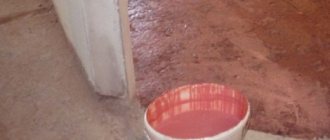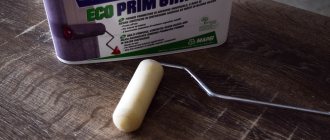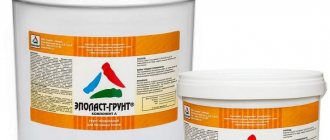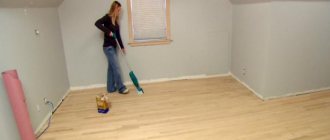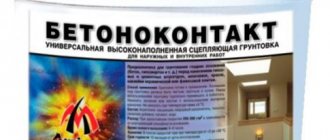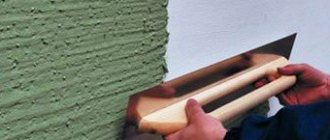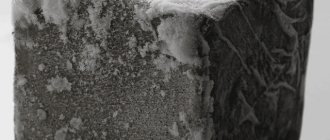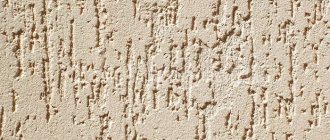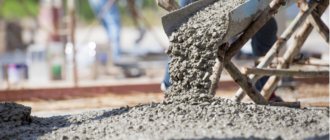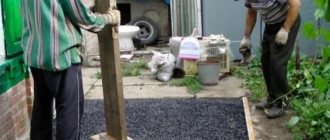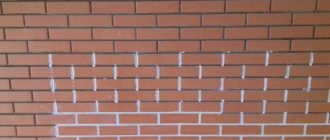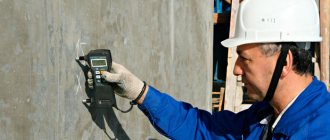Concrete contact "from the pink panther"
Once again, the construction and renovation season is in full swing, and again the dilemma of choosing the best building materials at reasonable prices arises. This is especially true for compounds whose effect is not noticeable immediately, but only in the long term. Therefore, we are considering in detail the question of which concrete contact is better, and whether it is worth spending money on it at all.
About the composition of the primer
The components of this unique material are:
- Quartz sand. Used to provide roughness to the surface. Roughness is necessary for the best adhesion to the paint layer or plaster solution.
- Pispersia styrene-acrylate. Used as a binder. It is necessary to create a homogeneous mass so that the primer does not spread during use.
- Cement. Added to give strength to walls or other treated surfaces. When applied to the surface, it creates resistance to shock loads or other negative factors.
- Fillers. Used as part of concrete contact to ensure thickness. Thick consistency is necessary for easy application to the surface.
On video: review of concrete contact primer Ceresit CT 19.
Popular manufacturers
Primer manufacturers are trying to give their product original properties. The best manufacturers of polymer primer “Betonokontakt” are considered to be “Knauf” and “Starateli”. Each mixture has distinctive properties.
The Knauf primer consists of quartz sand. It is available in five-liter containers. The product is suitable for treating concrete surfaces from the outside and inside. GB "Knauf" consumption per 1 m² is 0.23-0.4 kg. You can buy the material for 620-845 rubles.
"Betokontakt"
Ceresit also produces this type of primer mixture. The material is packaged in 15 liter buckets. The price of one container starts from 1190 rubles. The composition and quality of the mixture is almost the same as that of the manufacturer described above.
"Betonkontakt" from "Ceresit"
The best domestic manufacturer of GB is. The mixture is presented in 20 liter packaging. For one unit you will have to pay more than 1380 rubles. The quality of this primer is no worse than that of foreign analogues.
Domestic "Concrete-contact"
Purpose of the primer
Where is primer used and where can it be used? Why do you need to apply an additional layer? What is a primer? The following will help answer all these questions:
- The composition provides a bond between the treated surface and the applied coating. It is not surprising that if the surface of the walls or other bases is very smooth, the coating will adhere reliably for a long time.
- When applied to a metal surface, the metal gains greater strength.
- Concrete contact can be used for both porous and smooth surfaces.
- Contact concrete primer is used to apply plaster to monolithic concrete. This is an excellent solution, because when applying the plaster mortar in the usual way on a smooth surface, the mortar will slide off, which complicates the task of the master.
In what cases can you not do without concrete contact?
Concrete contact is a building material used for finishing surfaces. Sometimes it is mistakenly confused with an ordinary primer, but this is not entirely true. A primer is a whole “family” of compounds that improve adhesion.
So, a composition called concrete contact is intended for treating particularly dense, smooth bases such as concrete walls, ceilings, and floors. Therefore, when the question arises: which is better - concrete contact or a primer for a reinforced concrete base, we take the compositions according to their intended purpose, since they have their own special properties and functions.
If we want a reliable finish, we prepare the surface well
The purpose of any concrete contact is not just to level the walls, filling in holes and irregularities, but to prepare the surface for gluing any finishing material to it. For example, it is difficult to attach tiles to a wall even if a phenomenal adhesive is used. Whereas the use of concrete contact makes the mission feasible, and the duration of its effect is significantly extended.
On what surfaces is it applied?
The name concrete contact primer at first glance suggests that it can be used to process concrete, but this is a misconception. Concrete contact primers can be used to coat the following surfaces:
- clay or silicate brick;
- concrete with a dense structure;
- porous concrete such as foam concrete or aerated concrete;
- plasterboard, DSP, gypsum fiber boards;
- ceramic surface, including tiles;
- plastering with cement or gypsum mortar;
- oil painting;
- wooden and metal surfaces.
This list can be expanded, since the concrete contact mixture is truly universal.
On video: application of concrete contact.
Concrete contact: primer to improve adhesion of any surfaces
During the construction of a building, it often becomes necessary to connect together materials that have very low adhesive properties. For example, lay ceramic tiles on a wooden or metal base. Previously, builders tried to avoid such decisions, but today all restrictions have been lifted.
It is enough to simply use concrete contact primer, which slightly changes the characteristics of the materials being processed and allows them to be bonded together as firmly as possible using a special adhesive composition.
About the technical characteristics and application of the primer
Concrete contact, technical characteristics, which can be divided into several categories.
| No. | Technical properties | Exposure time | Indicators |
| 1. | Setting speed or how long it takes for concrete contact to dry | Drying speed of the primer layer is high | Drying time ranges from 1 hour to 3 hours, but depending on the area of the walls or other bases, how long the concrete contact will dry depends on the surface itself |
| 2. | Consumption rates | Based on the porosity of the surface layer, the flow range changes | From 150 grams to 500 must be consumed per 1 m2, but the average consumption is 300 grams per 1 m2 |
| 3. | Moisture resistance | Due to the applied layer, a water-repellent film is formed | |
| 4. | Service life or how long the primed coating lasts | A surface treated with plaster, putty or painted will last a long time | The service life is from 70 to 80 years, but it is necessary to carry out all technological measures correctly |
Drying time also depends on the condition of the surface. When applying a concrete contact primer, including axton, to the surface, the following subtleties must be taken into account:
- temperature and humidity conditions should be in the range: 5-30 C0 and not exceed 80% humidity;
- after treating the walls with a primer, before applying a paint or plaster layer, wait 12 hours until the surface with concrete contact completely sets;
- Apply the surface layer no later than every other day, so the adhesion properties will be preserved longer;
- The primer should be diluted with water;
- To calculate how much primer you need to purchase, you need to decide on the volume of the surface to be treated and take into account that 3.5 and 14 kilograms per pack are available for sale.
Since the material itself does not have a specific color, when repairing walls it is diluted with a pink color. This is necessary to recognize whether the entire surface has been processed and whether individual areas remain.
In retail sales, the primer is also available already in a diluted state, and there is another original offer - in spray cans.
What general properties does concrete contact have?
In a nutshell, the function of concrete contact is to create conditions for gluing foreign materials without the use of complex adhesives. The very composition of this type of soil allows it to “stick” to any surface. Unique adhesive ability is achieved by combining many elements.
Note: Special glue and quartz sand are required, which enhances adhesive properties. Sometimes the composition of the concrete contact is even supplemented with finely dispersed cement.
Primer Lakra betonokontakt for external work
Concrete contact primer has quite a wide range of applications:
- It perfectly bonds finishing and building materials with smooth, glossy surface textures.
- Improving the quality of adhesion of plastered walls.
- Finishing surfaces without preliminary cleaning of previously applied materials. As an example: a high-rise building with a tiled facade is easier to treat with concrete contact than to clean everything down to bare walls.
Note! Classic primer differs from concrete contact in slightly simplified functionality. It is often used when it is necessary to preserve the surface for the winter, and to perform other simple tasks.
Visualized technical characteristics of concrete contact primer
The concrete contact primer has characteristics of a higher class - they turn it into an indispensable independent material for finishing work:
- Long service life. Some manufacturers provide a guarantee of up to 80 years for the preservation of the properties of their products. Who will check the truth of such “speeches of the Reds”, because, most likely, during the specified time, restoration work will be carried out in the premises more than once.
- Drying speed . A correctly applied concrete contact layer needs no more than two to three hours for it to dry and work with it can continue.
- Moisture resistance. When it dries, a film forms on the surface of the concrete contact. It is absolutely waterproof and serves as waterproofing, thereby protecting the main surface of the wall from adverse influences.
- Low consumption . There are certain standards according to which a specific amount of substance is required per unit area. But, due to a number of circumstances, they cannot always be observed. Therefore, everything here is individual. Much depends on the surface being treated. Porous or rough texture will require a thicker layer of primer.
Traditionally, concrete contact primers are divided by type of surface and can be treated with a specific composition: for metal, wooden walls, and so on. However, in practice this is not always taken into account, since the classification is conditional.
Concrete contact primer, the composition of which is not always the same, must be purchased for specific work from a specific brand.
Some features
Why concrete contact is needed is already clear. But how to apply concrete contact primer to the surface in order to correctly perform the application technology? To ensure the preparation of surfaces, including the floor, you should remove dust, clean the old layer of paint and remove dirt and greasy stains. These are mandatory conditions.
After preparation, the following is a description of the work:
- Preparation of the solution. Mix thoroughly if possible using a mixer. This is done to prevent particles such as cement and sand from settling at the bottom of the container.
- If the solution turns out thick, dilute it with water.
- For direct application, you can use either a brush or a roller.
The manufacturer's instructions indicate applying only one layer of the composition to the surface, but if necessary, it is possible to reapply the layer.
How to dilute concrete contact and how to apply it to the surface?
It is worth noting that it is possible to buy concrete contact in finished form or as a dry mixture. The primer is sold in buckets or containers of both small sizes and over 20 kg. At the same time, there are packages of 3, 5, 10 kg, which also have good technical properties. What's better?
It's hard to say, since it all depends on your financial capabilities and personal preferences. It is clear that the ready-made mixture is somewhat more expensive, but there are fewer problems with it. Just open the lid, stir and you can start working.
During operation, the mixture can be stirred periodically so that it has an acceptable consistency and is convenient to work with.
A point regarding the drying time of the primer. We wrote that it dries within a few hours. It is worth noting that everything depends on the room temperature and humidity. Be that as it may, it is not recommended to start work until the concrete contact has completely dried. Dust or dirt or something else may get on it, and then in the future it will have a bad effect on the adhesion of the surface.
How to apply concrete contact?
There is nothing complicated: you can apply the glue either with a brush or a brush. Anyone who is comfortable can use a construction roller. Some people prefer a wide brush, as it allows them to penetrate well into all irregularities and apply glue evenly to the surface.
Then, after the concrete contact has dried, it is necessary to check the quality of work. There should be no gaps and the surface should be equally rough over the entire area. This can be determined by eye. If there are such defects, then you will need to apply a second layer of primer.
Important! It is worth understanding that although concrete contact adheres well to any surface, it must be clean and dry. Therefore, before starting work, it is necessary to clean the surface from dirt, dust and greasy stains. You should also remove anything that doesn't adhere well.
It should be remembered that soon after the concrete contact has completely dried, further work must begin. You should not put it off for the reason that dust will then get into the pores and roughness of the surface and this will worsen adhesion. Therefore, you should not prime a large area with concrete contact if you do not plan to carry out large-scale work immediately.
But what if the primer is used to preserve plastered walls? In this case, after a little time the surface must be cleaned again. This can be done by cleaning it with a deep penetration primer.
You can treat the surface, which you will later open with concrete contact, with a deep-penetrating primer initially. This will help reduce the cost of concrete contact by 1 sq. meter, since the surface will already stretch its strength and then absorb moisture equally.
Other applications
The creation of excellent adhesion and high strength characteristics contribute to the use of concrete contact for other purposes. List of other purposes for using primer:
- For gluing ceramic tiles to surfaces, including floors. To do this, dilute the dry mixture to a dough-like state. It is recommended to purchase a composition for gas silicate surfaces or a filler for heavy plastering work.
- To ensure water resistance for porous coatings, applying one layer of the material used is sufficient.
- For insulation in the ground against moisture penetration into concrete, cement or ceramic coatings.
Axton primer is in unprecedented demand and is used both for finishing work in construction and for home repairs.
When we renovate a residential building, the priority should be ensuring occupational safety and the use of environmentally friendly materials. Concrete contact mixtures, including Axton, are absolutely safe for humans, which is why they are incredibly popular. Any manufacturer supplies products with a detailed description, technical characteristics and rules for using concrete contact.
How to apply concrete contact (1 video)
Different types of concrete contact primer (25 photos)
How long does it take for Betonokontakt to dry?
An acrylic-based solution with the addition of cement, sand and special fillers is called Concrete Contact primer. They are used to treat surfaces before finishing finishing work in premises in order to enhance the adhesion of materials and reduce the consumption of compounds that will be applied subsequently. The improved technical characteristics of Betonokontakt soil allow it to be used for processing concrete and reinforced concrete surfaces, polystyrene foam and plasterboard sheets. The soil is also used to increase the adhesion of lime, gypsum and cement mixtures. Treating drywall with this solution significantly increases the strength of the material.
Technical characteristics of the Betonokontakt primer
- Increases the adhesion of materials due to the presence of purified quartz sand in the solution.
- Moisture-resistant, vapor-tight, dries quickly.
- Apply using a brush or roller.
- Helps save finishing material.
- Thanks to the presence of fungicidal additives, it reduces the risk of mold.
- It is safe for human health because it does not contain solvents.
We apply Concrete Contact to the cleaned surface, how long it dries depends on the conditions in which the work is carried out.
Application should be carried out at positive air temperatures and low relative humidity in the room. The composition is odorless, so you can work with it without using protective equipment. The pink color of the primer allows you to control the treatment area.
Consumption and drying time of soil Betonokontakt
It takes 0.3 kg of composition to treat 1 m2 in one layer. Knowing this, you can calculate the amount of solution required to treat the room. It is enough to sum up the area of all surfaces and divide the resulting figure by 0.3 kg. If the primer will be applied in two layers, multiply the resulting amount by 2.
Thus, you can determine the required amount of Concrete Contact, how long it will dry, you can find out from the instructions. The “Technological Information” states that the start of subsequent finishing work can begin no earlier than 12 hours after applying the primer at t +23°C and a relative humidity of 50% and no earlier than a day later at a relative humidity of 65% and t +20°С.
aquagroup.ru
Video “Application of concrete contact”
In this short video, an experienced craftsman talks about his experience of using concrete contact primer and shares his secrets.
We recommend that you read
What is acrylic primer: types and applications
How long does it take for the primer to dry?
Types of primers for walls and their use
How to use
When using concrete contact in repair work, you should remember that it is not exactly a primer. The solution is more like an adhesive composition. But unlike conventional glue, it is impossible to glue two sheets of paper together with this solution. The main task of such a primer lies in creating optimal conditions so that any other material (tiles, tiles, etc.) can be glued to the treated surface without any problems using a full-fledged adhesive composition. Therefore, this construction product can be used in the following situations:
- for gluing materials to glossy and smooth surfaces;
- to increase the adhesion of standard plaster to the surface of walls and ceilings when applying a sufficiently thick layer of finishing;
- for effective “preservation” of plastered surfaces in preparation for the cold season.
Please note that in the latter case, you can use a simplified version - a regular primer.
As a result, using this solution, you can do without the following work on preparing the base:
- removing plaster;
- removal of old cladding, including tiles and paint.
But here it should be remembered that preliminary preparation of the treated surface is not carried out if the finish retains its strength and does not fall off. Otherwise, applying concrete contact will not be able to increase the strength of the finish, and it will simply fall off under the weight of the new finishing material, ruining the appearance of the wall or ceiling.
Since this solution is considered a type of primer, the method of its application will not be much different. The method of using a Betocontact type primer is in fact practically no different from applying a regular primer to work surfaces. Even a beginner in the construction business can cope with such work.
The technology for applying this solution necessarily includes proper preparation.
Please note that preparation in this situation does not involve removing the finish. Here you just need to put its surface in order.
Any glue will poorly connect different materials together if their surface is dirty and dusty. In such a situation, contact will occur only between pieces of dirt, which will ultimately lead to a violation of the integrity of the finish. Therefore, before you start applying concrete contact to any type of surface, you should carry out the following manipulations:
- thoroughly wash the surface from all types of contaminants (for this you should use various cleaning products);
- rinse the area well with water;
- Allow the treated area to dry.
Only after such preparations can the solution be applied. As you can see, preparation in this case will take a little time.
Some experts note that for better application of concrete contact, cement and concrete surfaces should be pre-treated with a regular primer. Moreover, this approach will allow you to remove dirt and dust in one fell swoop, as well as strengthen the outer layer of the old finish. In addition, the primer should create a moisture-proof layer, which will reduce the consumption of concrete contact due to the fact that it will be evenly absorbed into the walls or ceiling. But in such a situation you will have to wait a little, since the primer takes longer to dry than water.
The solution itself is applied as follows:
- pour betocontact into the container for working with the roller;
- then we lower the roller into it and wet it well in the solution;
- after this, the roller must be squeezed out so that the solution does not drip;
- we go through the previously prepared zones with a roller;
- The solution must be thoroughly rubbed over the surface to reduce its consumption.
Remember that the concrete contact must completely cover the work area.
After this, you need to let the solution dry and you can proceed to the next stage of finishing.
As you can see, working with concrete contact is simple. And its use brings with it a lot of positive aspects.
